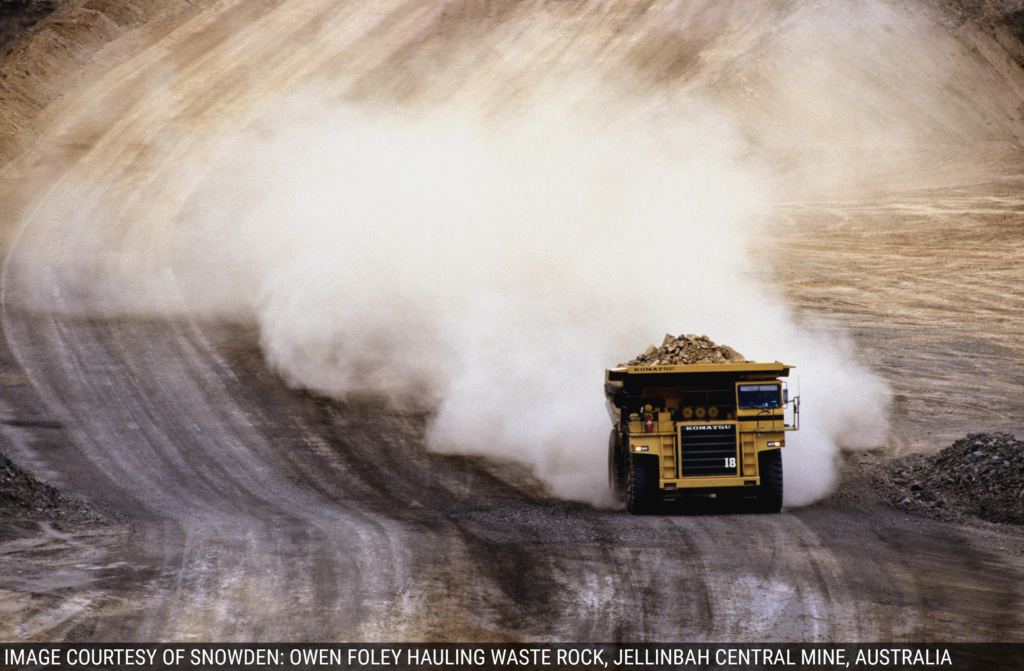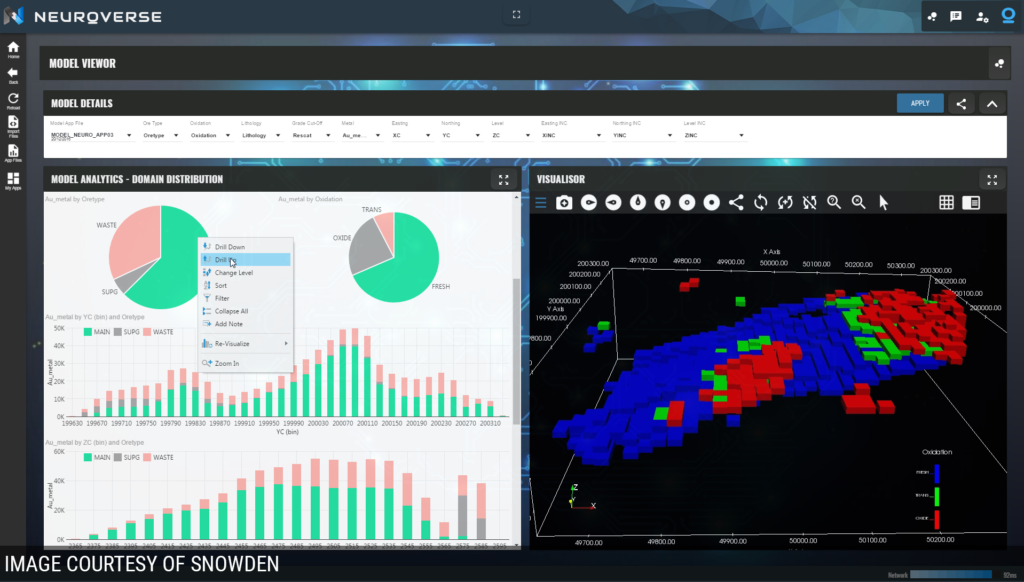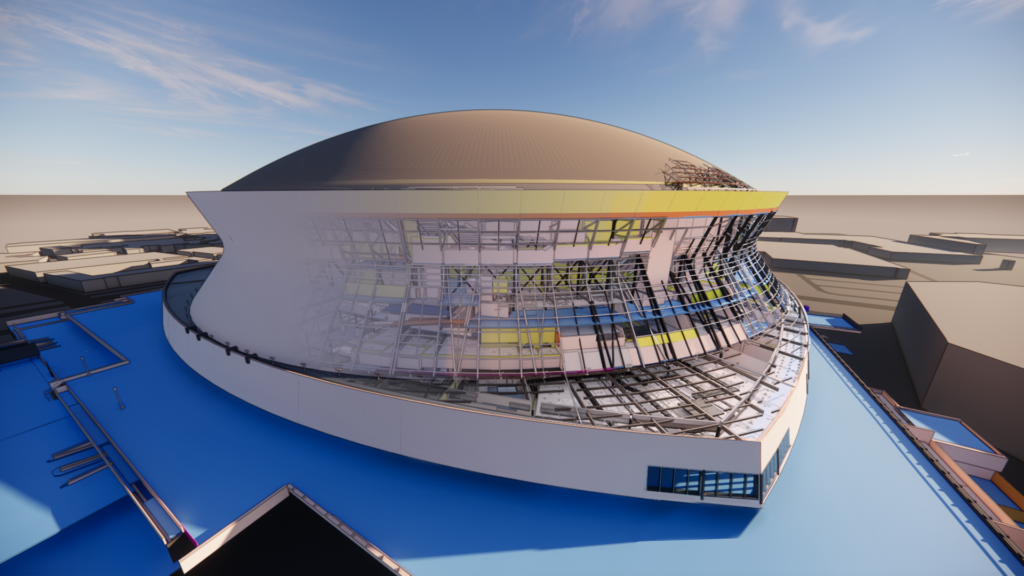Snowden Takes Mining Intelligence to the Cloud with Neuroverse

Mining in the 21st Century is a far cry from what it was 100 years ago. The days of “hitting pay dirt” based on local knowledge, inspired guesswork or pure luck are long gone. Today mining is a high-tech, data-intensive, and competitive industry with a reliance on state of the art tools that facilitate targeted exploration and enable high productivity, operational efficiency, agility and speed. Central to achieving these goals are the insight and intelligence provided by the vast amounts of data that mining companies gather every day about all aspects of their operations. Coming from a wide array of sources, data is gathered on everything from geological investigations and mine facilities, to fleet maintenance and financial performance.
For 30 years, Perth-based Snowden has provided specialized software and consulting services to enable the global mining industry to aggregate, analyze, transform and act on this data. Australia has long been recognized as a hub for mining innovation, and with experience from over 12,000 mining-related projects, mostly in Australia and South Africa, and a suite of industry-leading on-premises software solutions, Snowden is well-positioned to see the technology trends transforming the industry. Among the industry trends Snowden noticed was a desire to reduce the reliance on traditional on-premises enterprise software solutions, with their high upfront costs, relative inflexibility, and long deployment cycles, and move instead to lower cost, consumption-based, easy to deploy, and flexible alternatives. Additionally, customers were increasingly looking for more real-time business insights that would be available to more people, no matter where they might be or on what device.
Armed with these insights, and grounded by deep domain and software expertise, Snowden recently launched a revolutionary SaaS solution for the mining industry, Neuroverse, built on top of Microsoft’s Azure cloud platform. Leveraging the unique attributes of the cloud, and the UX-centric, “any place, any time, any device” ethos of the mobile app era, Neuroverse takes a subset of the existing capabilities of Snowden’s on-premises mining software solutions, and extends and enhances these in the ways their customers were seeking.
The Challenge of Mining Data
Neuroverse is a cross-platform, cloud-hosted solution for analyzing, exploring and visualizing data. Within mining, the most valuable data collected is the geostatistical data that drives and informs the actual mining decisions. In standard practice this data is collected in the field by geologists drilling holes in areas previously identified as good candidates for the desired ore bodies. Drill core samples are returned to labs where they are assayed to identify depth, grade, distribution, etc. of the ores across the defined area. The geostatistical information extracted from these assays is loaded into databases and utilized within specialized on-premises software, such as Snowden’s own Supervisor tool, for statistical analysis and 3D modeling. Traditionally, the end users of this data have been the on-site technical staff and management, sitting in front of the workstation alongside the trained operator of the software. This situation makes collaborative and rapid decision-making difficult, and also encourages a mindset in which information exists in silos, accessible only to some, and viewed separately from other complementary information existing in different silos. In this mode of working, business visibility and intelligence are always localized, partial, and usually dated by the time it reaches the key decision-makers.
Part of Snowden’s goal with Neuroverse was to break this pattern and enable true collaboration, innovation, and business agility across a mining enterprise. Neuroverse would achieve this by making both the data and the tools for viewing and exploiting it, universally and rapidly available to users through a standard web browser on any computer or mobile device with Internet access. However, almost immediately, Snowden identified a major obstacle to this vision. The geospatial data — and the geological resource block models built from these — are typically exported as large .csv files, often many gigabytes in size. Moreover, many mining operations are in remote areas where connectivity to the Internet is less than ideal. According to Sean Helm, Snowden’s Product Portfolio Manager:
“The first thing everyone said when we pitched the idea of Neuroverse was ‘we have these massive models — how are we going to get them up there and get people to use a cloud platform over a desktop application if they have to wait 30 minutes, an hour, two hours or more to get them up there?’ ”
Being able to optimize the utilization of the available bandwidth and move the large data files into the cloud in a timely fashion — in minutes rather than hours — required something more than regular HTTP.
Adding the Missing Ingredient — Fast File Uploads to the Cloud
At this point Snowden researched the available options for high-speed delivery of large files to cloud object storage over high latency networks. After evaluating different vendor solutions, Snowden quickly settled on the Web Transfer API variant of Signiant’s Flight. As a cloud-native SaaS solution for accelerating file uploads to cloud object storage, Flight was a natural fit for the Neuroverse cloud platform. With an auto-scaling, load-balanced cloud infrastructure managed by Signiant, Flight is a breakthrough solution for high-speed transfers of any size file, over any distance, and any network, to leading public cloud platforms, including Microsoft’s Azure Blob storage. The Web Transfer API option enabled Snowden to easily build Signiant’s industry leading file acceleration directly into the Neuroverse end-user web interface, and thereby provide their mining industry clients with the ability to upload their block models, or other large data sets, at maximum speed, no matter what the available bandwidth.
Using built-in Signiant acceleration to overcome the challenges of latency with large file transfers, Snowden is now able to offer their mining industry clients, through Neuroverse, a state of the art platform for uploading, viewing and analyzing their core business data. Moreover, Neuroverse presents the identical experience on desktops, tablets, even smartphones. With the scalability, reliability, security and global availability of the Microsoft Azure platform behind it, Neuroverse is a compelling option for an industry requiring rock solid solutions that work 24/7, all around the world.

Neuroverse: The Future of Mining Intelligence
On the front-end Neuroverse presents to the user an extensive suite of tools — called Snowden Apps or “SnApps” — that collectively provide dashboards, analytics and 3D visualization modules. In the Neuroverse workflow, the geological block models, drill-hole data, or other mining operations data, are uploaded from the customer site to the Snowden tenancy on Azure Blob storage via the web browser GUI. This data is then available to all authorized users through the same GUI, close to real-time, for analysis and visualization using the SnApps. Mindful of the importance of the user experience, Snowden presents SnApps as tiles on a GUI in a manner users are familiar with from the interfaces and apps on their tablets and smartphones. Stuart Trotter, Snowden’s Software Development Manager, explains:
“The goal was to try to define the constraints and limits of each of those tiles so that they behave like an app as well. A big part of that is the speed and upload ability we have from Signiant. People using their apps don’t want to wait around for hours for their data. They want things to be snappy and fast, so that was one of the initial drivers to go and look for high speed uploads, and Signiant was the one that we came to in the end.”
Unique in the industry, Neuroverse enables users to interactively view and manipulate integrated dashboard-style statistical analyses and 3D visualization models within a single screen. Moreover, changes or drill-downs in the former are instantly rendered (in the cloud) and displayed as the latter. So, for example, a user can simultaneously look at an analytics style dashboard and 3D model that describes the distribution of metal within an ore body. At any point they can then drill down into the data and see, for example, the total amount of gold ounces in that main ore zone, and then see automatically generated 3D models representing the geospatial distribution of this gold in terms of the Northing, Easting, and Reduced Level (RL) coordinates. And they can do this in close to real-time thanks to Signiant acceleration.

Geostatistical data and resource block models are just one kind of mining industry data that users can upload into Neuroverse. Snowden’s legacy portfolio of on-premises software solutions addresses virtually every aspect of the mining business — from financials and site management to equipment maintenance and drill and blast operations — and all of these capabilities, and more, can be provided as SnApps on Neuroverse. The goal for Snowden is to move their mining clients gradually away from their on-premises solutions and instead make Neuroverse the place customers go for all their mining intelligence needs.
What’s Next for Neuroverse?
Traditional data of the types Snowden’s legacy applications were designed to work with is no longer the only kind of data available to, or important within, the mining industry. Increasingly whole new classes of data, gathered by “connected devices” and falling within the general “Internet of Things (IoT)” category, are now available for capture, distribution and analysis in much the same way. Real-time, or near real-time, data on areas as varied as component failure, dust management, traffic and weather, fleet maintenance, plant performance, and so on, all fall within this category and can usefully supplement and enrich other more traditional data already utilized. As Snowden’s General Manager of Technology, Jason Pearce, puts it:
“The ability to consolidate all this information on a single analytical platform, and compare intelligence from traditional data sources with data from less obvious sources, creates a very valuable solution for mining operations.”
Much of this data is already supported by Neuroverse utilizing Azure’s IoT Hub on the back-end to manage the messaging.
It is early days for Snowden with this kind of data. But as its importance and ubiquity within the mining industry grows, and as more classes get added, some of which will include very large files such as video files from drones or CCTV sources, the need for Signiant acceleration to move these IoT-sourced data classes to the cloud for Neuroverse-enabled analysis will expand correspondingly.
Moreover, mining is no longer the whole story. Indeed, other divisions within Snowden’s corporate parent, Downer Group, such as units specializing in light-rail and mining tire maintenance, are among the first clients using Neuroverse for their daily operations.
The future is an exciting one for Snowden and Neuroverse. Wherever they go they know they can always rely on Signiant acceleration to move their data to the cloud, securely, reliably and fast.
Banner image courtesy of Snowden: Asier Ramirez – Mediterranean mining, Mochlos, Greece


